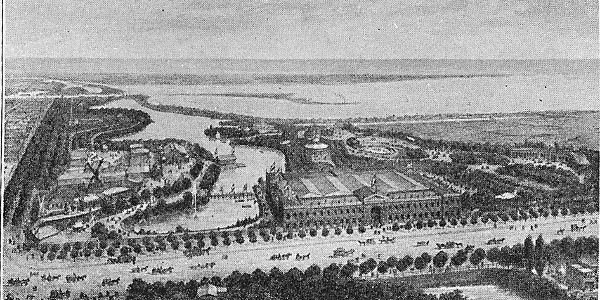
COPENHAGEN, DENMARK 1872
Scandinavian Industry and Art Exhibition
Sponsor this page for $75 per year. Your banner or text ad can fill the space above.
Click here to Sponsor the page and how to reserve your ad.
Quick List Info
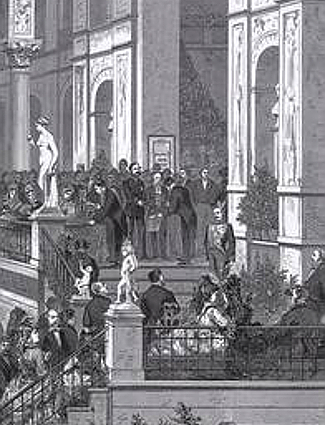
Dates Open - June 13 to November 1, 1872. Assumed open all days.
Attendance - 600,000.
International Participants - 10 plus.
Total Cost - Not available. Sponsored by state and private funds.
Site Acreage - Buildings were located on 7 acres. Total acreage unknown.
Sanction and Type - Prior to the Bureau of International
Exhibitions. Copenhagen 1872 would be considered a Special Expo event on specific themes, with limited acreage, like that on the 2-3 or 7-8 years of a decade cycle.
Ticket Cost - The opening day (ceremony begins at 12 o'clock) 5 rdl. cited for all the time, (opening and medal days included) 10 rdl., from 14th of June 5 rdl. for a period of 14 days 3 rdl .; for a period of 7 days 2 rdl .; about saturday 64 sk .; the other days of the week 32 sk.; 6 weeks after the opening of the exhibition every Sunday 16 sk.
Photo top center: Overhead view of the building and grounds of the Copenhagen Exhibition of 1872, 1919, Det gamle Kobenhavn, Volume 2 by Knud Bokkenheuser. Courtesy Wikipedia Commons. Column Top: Engraving of the Awards Ceremony with King Christian IX of Denmark, Original Source unknown. Courtesy Pinterest.
Other Histories of World's Fairs to Check Out
-
Quick List of All Expos
1st World's Fair in History
London 1851
Paris 1855
London 1862
Paris 1867
Paris 1889
Copenhagen 1888
St. Louis 1904
Vancouver 1986
Shanghai 2010
Milan 2015
- For more info about the World's Fair Decision Model, development of the model, the study participants, etc. The development is currently being utilized for in-house publishing projects, but is not available for work-for-hire decuments or consulting.
- For More info about the Bureau of International Exhibitions - Sanctioning body for international exposition (world's fairs) headquartered in Paris, France.
- For more info about previous EXPOcheck reports.
History of the Event
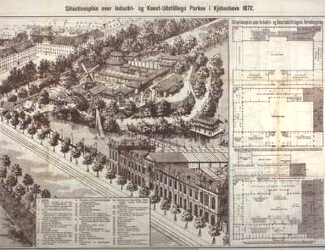
It was time for Denmark to get into the exhibition act with the Scandinavian (some referred to it as Nordic) Industry and Art Exhibition held on the site of today's City Hall Square. The Danish-Prussian War of 1864 was over, and the conservative Hojre political party had control of parliament and desired to join the world's fair movement to show off its agricultural (which had gone through recent down years) industrial, and art progress. An exhibition building was constructed in European Exhibition Style by the Industrial Association, the exhibition was backed by King Christian IX, and categories were used for exhibits like that at Paris 1867. The building would be the home of the Industrial Association after the exhibition and remained as part of Copenhagen into the 1970's. It is no longer there.
There was an exuberant feel on opening day for the exhibition with 3,673 exhibitors showing their goods (half Danish, half international), fair weather, and what the London Times termed a "decided success" even though the fair was only day old. The Royal family participated, as well as the Prime Minister. Copenhagen had held previous exhibitions on a regional and national scale, so the city was experienced with the influx of crowds, although these crowd would prove to be larger. The last national exhibition had been held there in 1852; the first Scandinavian Exhibition in Stockholm in 1866. The Scandinavian Industry and Art Exhibition of 1872 would be constructed in the area of the Western Passage, near Tivoli Garden, which had been founded in 1843. The exhibition would be built on both even ground and the ditch. It was noted that the site prior to opening day was criticized, but after the exhibition palace was constructed, the uneven ground gave the fair a favourable look.
The exhibition opened every day at 10:00 a.m., except on Saturday when it opened at noon. Closed at 7:00 p.m. daily.
The fair was considered a complete look at the progress of Scandinavian art and industry. Congresses were held, including the Scandinavian Industrial Congress, adding to the luster. Attendance of six hundred thousand visitors during the nearly five month run spoke to its success. The London Times reported that many attended from Germany and Denmark, but not that many English. It did not, however, hurt the overall financial success of the exhibition.
Above image. Map of the Copenhagen Exhibition Grounds, 1872, Royal Library. Below: Medal awarded at the Exhibition, 1872. Courtesy Pinterest.
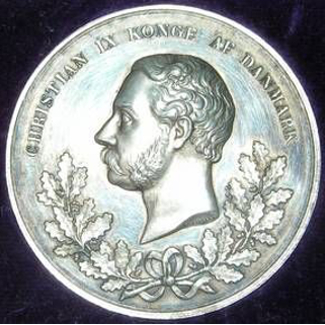
Perspective of Historians
Margit Mogenson - "The 1872 fair was a rather traditional project, dominated by the Right (conservative) oriented Industrial Association of Copenhagen. (Theme) Copenhagen prospered by both (1872 & 1888) exhibitions, partly because of the themes (industry, progress, history etc.) partly by new buildings and gardens and the fact that the city became familiar with such partly international events.
Just before the opening in 1872, Copenhagen saw its first socialistic revolt. The police and government were very much concerned on the unexpected situation that probably influenced on the whole atmosphere.
Visitors in such a big scale were never seen before. It caused problems as it created the ground for new initatives. Sponsoring by the Danish State and the great private associations. It was in those days rather easy to get money for national and nordic exhibitions. Much more difficult for international purposes."

London Series
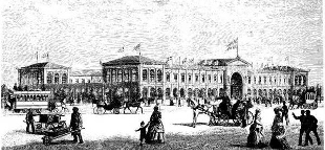
International Participants
Nations and Colonies
Denmark, Germany, France, Belgium, Netherlands, England, Austria, Sweden, Norway, Finland.
There may be some differences in the overall list here than were actually exhibiting at the exhibition. Various sources may indicate participation when participation did not occur. Use the above as a guide, not gospel.
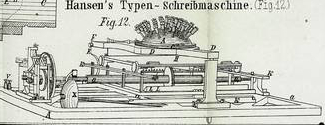
Expo Tidbits
Main building had four wings with glass-enclosed Court and four stories.
Pastor R. Malling Hansen exhibited four examples of his writing ball instrument, an early typewriter, winning a First Prize Medal. Another prize award winner was Rosenborg Springs, with a silver medal. One third of all exhibitors got an award.
Legacies
City hall square in Copenhagen now occupies the site of the Scandinavian Industry and Art Exhibition.
Those in Charge
Architect was Vilhelm Klein. L. IT. G. II. Holstein, President; E. Emil Rosenorn, Vice President; Election Council, Mayor E. D. Ehlers, Commissioner for the Evaluation; Mayor G. Christensen, Commissioner for the Exhibition and Exhibition Arrangements; Professor Heinr. Hansen, Commissioner for the Art Department; Professor C. Holten, Industrial Affairs Commissioner; Wholesaler W. P. Boryen, Commissioner for the Exhibition Finance; Eng. B. Jensen, Office Manager of the Exhibition; and Attorney General Camillus Nyrop, Secretary of the Bureau.
Sources: London Times; "The Time of Fairy Tales, Danish Participation in the World Expositions, 1851-1900," 1993, Margit Mogensen; Wikipedia Commons; Malling-Hansen.org; The Nordic Art and Industrial Exhibition in Copenhagen 1872, O. Rosenberg, 1872.
Photo column top: Drawing of the Copenhagen Exhibition Building prior to the fair, 1870, Illustreret Tidende. Courtesy Pinterest via Malling-Hansen.org. Middle: Exhibit of a Writing Ball, Typewriter, from Malling-Hansen, 1872, Polytechnisches Journal, Engineer. Courtesy Malling-Hansen.org.
There may be some differences in the overall list here than were actually exhibiting at the exhibition. Various sources may indicate participation when participation did not occur. Use the above as a guide, not gospel.

Main building had four wings with glass-enclosed Court and four stories.
Pastor R. Malling Hansen exhibited four examples of his writing ball instrument, an early typewriter, winning a First Prize Medal. Another prize award winner was Rosenborg Springs, with a silver medal. One third of all exhibitors got an award.
Legacies
City hall square in Copenhagen now occupies the site of the Scandinavian Industry and Art Exhibition.
Those in Charge
Architect was Vilhelm Klein. L. IT. G. II. Holstein, President; E. Emil Rosenorn, Vice President; Election Council, Mayor E. D. Ehlers, Commissioner for the Evaluation; Mayor G. Christensen, Commissioner for the Exhibition and Exhibition Arrangements; Professor Heinr. Hansen, Commissioner for the Art Department; Professor C. Holten, Industrial Affairs Commissioner; Wholesaler W. P. Boryen, Commissioner for the Exhibition Finance; Eng. B. Jensen, Office Manager of the Exhibition; and Attorney General Camillus Nyrop, Secretary of the Bureau.
Sources: London Times; "The Time of Fairy Tales, Danish Participation in the World Expositions, 1851-1900," 1993, Margit Mogensen; Wikipedia Commons; Malling-Hansen.org; The Nordic Art and Industrial Exhibition in Copenhagen 1872, O. Rosenberg, 1872.
Photo column top: Drawing of the Copenhagen Exhibition Building prior to the fair, 1870, Illustreret Tidende. Courtesy Pinterest via Malling-Hansen.org. Middle: Exhibit of a Writing Ball, Typewriter, from Malling-Hansen, 1872, Polytechnisches Journal, Engineer. Courtesy Malling-Hansen.org.
History of America
Check out our partners at America's Best History for the history of the United States. Great for students of history or just those that want to find out a little more about the whats, when, wheres, and how of heritage tourism.

To the 1870s
Baseball Stat Books

-
Stat Geek Baseball, the Best Ever Book
Stat Geek Baseball, the Best Ever Book. Some of the most unique info on the Best Ever in baseball you'll get anywhere! The Best Yankee! The Best Red Sox! The Best of Every Team!
-

-
Fields of Gold, Baseball's Best Glove Work
The newest book in the Stat Geek Baseball universe. Fields of Gold, Baseball's Best Glove Work. It's what the Best Ever Book was for hitting and pitching, but now a detailed look at the Best Fielders in Baseball History, including best position players for every team, and best overall for every position
